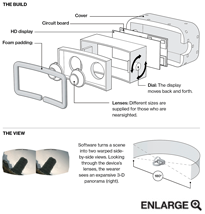Thirty years after virtual-reality goggles and immersive virtual worlds made their debut, the technology finally seems poised for widespread use.
Breakthrough
High-quality virtual-reality hardware that is cheap enough for the consumer market.
Why It Matters
Visually immersive interfaces will lead to new forms of entertainment and communications.
Key Players
- Oculus Vry
- Vuzix
- Nvidia
Palmer Luckey had not been born when The Lawnmower Man was released in 1992, but the movie, with its vision of computer-generated sensory immersion, helped seed his interest in virtual reality as soon as he saw it. He dreamed of playing video games in simulated 3-D worlds—a dream that led him to amass one of the world’s largest collections of head-mounted displays and, eventually, inspired him to attempt to make his own. With no formal engineering training, Luckey designed his first working prototype in his garage at the age of 16.
Today, the 21-year-old is the founder of Oculus VR, a company that is on the verge of releasing the Rift, an affordable virtual-reality headset for playing ultra-immersive video games. Facebook bought the company for $2 billion this spring.
Oculus VR had already attracted more than $91 million in venture funding, a near-fanatical following, and team members like the game programmer John Carmack, who led the development of influential video games such as Doom, Quake, and Rage. But the Facebook deal is a sign of faith that virtual reality is now sharp enough and cheap enough to have huge potential for more than video games. The idea of merging immersive virtual reality with social communications is intriguing. It could also be a compelling tool for teleconferencing, online shopping, or more passive forms of entertainment. Some filmmakers are, in fact, already experimenting with movies designed just for the Rift.
Virtual-reality headsets could be found in some arcades when The Lawnmower Man was in the theaters. But the technology wasn’t good enough to catch on widely. This time around, Luckey realized that cheap smartphone components could be combined to stunning effect, rendering bright, crisp worlds much more compelling than the blocky graphics often seen through earlier virtual-reality headsets.
When you use the Rift, you feel as though you’re actually inside these worlds. The technology follows the movement of your head in real time; lean in to take a better look at a virtual flower or look to the skies to gaze at a virtual cloud, and your mind is drawn into the simulation. You can almost believe you are fully there.
The vast audience for home video games appears hungry for the device. In August 2012, Oculus VR set out to raise $250,000 on Kickstarter and met the goal in a matter of hours. It surpassed $1 million within two days.
Luckey started shipping a version of the Rift for software developers in March 2013 for just $300, and in the past year, the hardware has improved significantly. The retail version, which is expected to launch later this year or early next, will offer resolution higher than 1,920 by 1,080 pixels per eye. Such stunningly sharp definition has only recently become possible at such a low price.
While video games are where this improved virtual-reality technology is likely to take off first, it could also have applications in telepresence, architecture, computer-aided design, emergency response training, and phobia therapy.
Indeed, in some niches, older VR technology has been in use for years. Some surgeons routinely practice operations using VR simulations, while some industrial designers use the technology to view their designs as if they had already been constructed. But 30 years ago, when Jaron Lanier founded VPL Research, the first company to sell virtual-reality goggles, such products were too expensive for the consumer mainstream (a single head-mounted display cost as much as $100,000).
There were other reasons, too, that earlier versions of virtual reality failed commercially. Players of Nintendo’s Virtual Boy, a low-end VR game system launched in the mid-1990s, complained of nausea after extended play. For other players, the keen sense of wonder and presence they felt inside a virtual world soon dissipated. “Your first time playing a game in a virtual world is incredible,” Lanier says, “but the 20th time is wearying.”
Things may be different now. Though some testers have experienced nausea using the Oculus Rift, the company says the latest version has almost eliminated this problem. And today’s virtual environments offer so much more fidelity that they could remain captivating for much longer. Artists have been able to create a more stimulating range of worlds, from the rigorously realistic to the more abstract and painterly.
Already Oculus has inspired imitators. Acknowledging the Rift as an inspiration, Sony has demonstrated a VR headset that players will be able to use with the PlayStation 4. Sony is also working with NASA to create a virtual-reality simulation of Mars using images pulled from the Mars Rover. A more mundane but potentially useful application that Sony is exploring would let travelers visit virtual hotel rooms before booking the real thing. Assuming they ever want to take the headsets off.
—Simon Parkin



Nenhum comentário:
Postar um comentário
Observação: somente um membro deste blog pode postar um comentário.